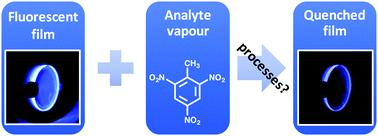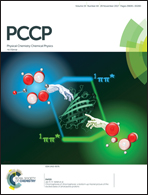Real-time fluorescence quenching-based detection of nitro-containing explosive vapours: what are the key processes?
Abstract
The detection of explosives continues to be a pressing global challenge with many potential technologies being pursued by the scientific research community. Luminescence-based detection of explosive vapours with an organic semiconductor has attracted much interest because of its potential for detectors that have high sensitivity, compact form factor, simple operation and low-cost. Despite the abundance of literature on novel sensor materials systems there are relatively few mechanistic studies targeted towards vapour-based sensing. In this Perspective, we will review the progress that has been made in understanding the processes that control the real-time luminescence quenching of thin films by analyte vapours. These are the non-radiative quenching process by which the sensor exciton decays, the analyte–sensor intermolecular binding interaction, and the diffusion process for the analyte vapours in the film. We comment on the contributions of each of these processes towards the sensing response and, in particular, the relative roles of analyte diffusion and exciton diffusion. While the latter has been historically judged to be one of, if not the primary, causes for the high sensitivity of many conjugated polymers to nitrated vapours, recent evidence suggests that long exciton diffusion lengths are unnecessary. The implications of these results on the development of sensor materials for real-time detection are discussed.

- This article is part of the themed collection: PCCP Perspectives


 Please wait while we load your content...
Please wait while we load your content...